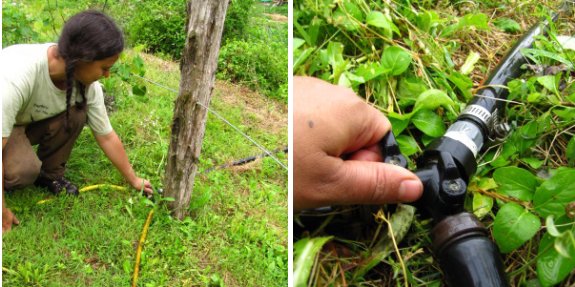
Why I chose this Y-connector over the others

This hose splitter with
control valves is metal with a plastic coating. It cost a couple bucks
more than the all metal or all plastic, but it's money well spent if
you need to leave this stuff outside all season long.
Maybe I should build a cover for it to provide some shade and reduce the UV exposure
to help it last even longer?
Want more in-depth information? Browse through our books.
Or explore more posts by date or by subject.
About us: Anna Hess and Mark Hamilton spent over a decade living self-sufficiently in the mountains of Virginia before moving north to start over from scratch in the foothills of Ohio. They've experimented with permaculture, no-till gardening, trailersteading, home-based microbusinesses and much more, writing about their adventures in both blogs and books.
Want to be notified when new comments are posted on this page? Click on the RSS button after you add a comment to subscribe to the comment feed, or simply check the box beside "email replies to me" while writing your comment.

I don't think you need to bother. I guess that the plastic is actually powder coating, which is pretty tough. Powder coating for outside applications is usually guaranteed to last at least 10 years. I'd think that a thermosetting powdercoat will last longer than a thermoplastic one, but even the latter will usually only melt around 350 F. (A cured thermoset will not melt at all, only soften.)
That's an intersting question. Most garden furniture is made from thermoplastics PE and sometimes PP. The reason is that they are relatively cheap, have a low melting temperature and are therefore easy to shape using injection molding. They are also relatively easy to recycle. Thermoplastic molecules consist of long chains of carbon atoms strung together, with other atoms or molecules sticking to the sides. Conceptually thermoplastics in solid form can be thought of as like cold spaghetti, but sticking together due to Van der Waals forces instead of sauce.
If you chop up the spaghetti into tiny bits, it won't stick together as well. So if the polymer chains in thermoplastics are broken due to e.g. high-energy radiation (UV) or other environmental influences, the strength of the material decreases, and after a certain time it fails.
Now, there are engineering thermoplastics like PEEK and PEI that are more resilient. But they are much more expensive and harder to process. They are mainly found in parts for aerospace applications.
If a thermoplastic is like cold spaghetti, then thermosetting plastics can be thought of as cold spaghetti where the strands are connected by other strands. This is called cross-linking. The cross-links are made my mixing several components which then undergo a chemical reaction. Some examples are Bakelite and epoxy. (The name "polyester" can refer both to a thermoplastic and a thermoset. An example of the former is PET, while thermosetting polyester is widely used to fabricate Glassfiber Reinforced Plastic or GRP).
Due to the cross-linking, thermosets are much more resistant against radiation. All the chains are connected, so breaking some chains doesn't really harm the structure. In essence, a piece of thermoset is one giant molecule. Generally they last much longer outside than the thermoplastics. They are also incapable of melting, although they will go soft when heated above their glass transition temperature.
So if you want plastic parts to last a long time outside, thermosets like epoxy and polyester (especially when combined with fiberglass) are a good choice.
I have had an ongoing pain in my behind with basic equipment failing on a regular basis. It drives me nuts to buy a Y-valve and then have it rupture just a year later, yet that is exactly what I've had happen year after year. Tell you what, you keep posting what you use, exact model, where you bought it and how long it lasts and I'll do the same thing. If we both keep it up we can reward the companies making good gear and stop buying junk that cracks in just a years time.
My reciprocal recommendation for you today? Round House overalls. They're cheap at $23 a pair. And they're made in America unlike Carhart! I've had nothing but good luck with them so far.